What is the structural Coloration in Butterfly Wings?
Certain colors in butterfly wings come from light bending and reflecting off of the nanostructure of scales. Researchers are investigating how this ability in butterflies was developed and how it could replace our current processes to create structural coloration.
How Butterfly Wings Achieve Brilliant Colors?
For most people, even hearing the term, “butterfly,” evokes images full of colorful symmetries. This beautiful insect has fascinated both poets and scientists with its brightly colored wings and conspicuous, fluttering flight. While one would assume that butterfly wings are a mosaic of brightly colored pigments, this is not always the case. Many of the colors such as reds, yellows, and browns are derived from pigments, but other colors especially blues and greens are derived from the reflection and bending of light by the nanostructure of scales on butterfly wings. This phenomenon is called structural coloration and is a common way by which several species of butterflies and even peacock feathers achieve brilliant iridescent coloration.
Research on Butterfly Structural Coloration by Dr. Patel
At the Society for Developmental Biology annual meeting this year, Dr. Nipam Patel from UC Berkeley talked about his passion for studying structural coloration in butterfly wings. Although the physics of this optical phenomenon is well-understood, Dr. Patel’s lab is currently working on elucidating the less understood developmental processes of the wing-nanostructures responsible for this coloration. These questions are being investigated in a variety of butterfly species using a combination of microscopy, cell biology, and bioinformatics.
The technical challenges of working with fragile butterfly wings, especially in the pupal stages are great. A JoVE Video Journal Article, Ramos and Monteiro; 2007, from SUNY and Yale University details a protocol to dissect, fix and study butterfly pupal wings.
Conclusion
Structural colors can have a variety of potential applications, due to their long-term resistance to discoloration via chemical changes as well as being superior from an ecological perspective. Current industrial processes to create structural colors use a costly method of depositing layers of heavy metals by electricity. By contrast, butterflies can accomplish this feat with simple elegance using just strings of sugar molecules.

